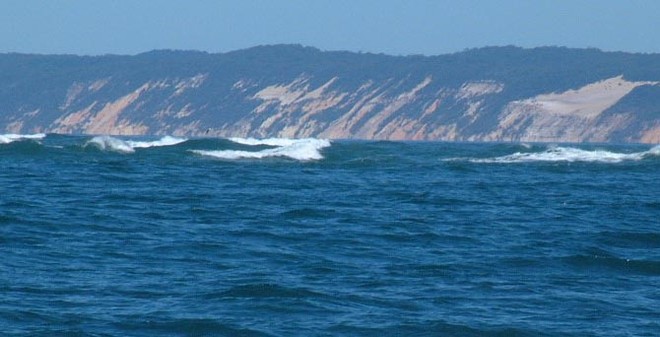Using simple danger bearings for sailing navigation safety
by John Jamieson on 31 Dec 2011

the treacherous Wide Bay Bar - shallow, with breaking surf on one side and rocks on the other SW
Strong winds heel your cruising boat as you approach the rock-infested entrance to the pristine cove you’ve selected for an anchorage. Your main concerns are those ship-killing rocks on the starboard side of the entrance. What‘s the fastest, easiest method to back up your GPS navigation for safe passage?
It's easy to ignore traditional forms of navigation with so many touch-pad black box navigation devices at your fingertips. Shorthanded sailors in particular need fast, easy, works-every-time methods that require a minimum of chart work.
Use the simple danger. All your chart work can be done dozens of miles before you get close to shoals or dangerous reefs. It's fast, fun, easy, and accurate. Grab your trusty hand bearing compass and follow these easy steps:
1. Choose a Prominent Object:
Study your navigation chart and find a prominent object on the same side as the danger.
For example, if an outcrop of dangerous rocks lies to starboard, select a prominent tank, tower, lighthouse or other object on the far side of the danger on the starboard side. Note in the illustration that the dangerous reef lies to starboard. The sailing skipper chooses a prominent Tank (note: on nautical charts--prominent, easy-to-see objects are always labeled in all capitals) on the far side of the dangerous reef on the same side as the danger (to starboard).
2. Plot the Danger Bearing Line:
Draw a line from the charted object back out onto the water (see illustration) on the outer edge of the danger. Note in the illustration how the line clears the danger. Extend the line far enough so that you can start taking bearings one to two miles before you pass the danger.
3. Measure the Danger Bearing Line:
Find the magnetic bearing of your prominent object. This will be the danger bearing you'll use. Check your measurement three times for safety's sake. That might seem silly, but parallel rules, protractors, and other measuring tools can slip and slide. Your bearings should read the same.
4. Label the Top of the Danger Bearing Line:
Label lines for safety. Not many things are as important as crystal clear labels in navigation, in particular with short-handed crews in tough sailing conditions. Danger bearings are always labeled to tell you in an instant whether any bearing you take to the prominent object will be dangerous. Prefix your danger bearing with NMT (Not More Than) for dangers to port. Prefix your danger bearing with NLT (Not Less Than) for dangers to starboard.
Notice in the illustration the danger lies to starboard, so we prefix the danger bearing with NLT. This means any bearing we take to the prominent object--in this case a Tank--should read 045M or higher. If we take a bearing of 045M, 046M, 047M, 048M… we are sailing in deep water. If we take a bearing less than 045M (i.e. 044, 043, 042…), we are standing into danger, and must change course away from the danger.
5. Take Bearings Often:
As soon as you sight your prominent object, start taking danger bearings. Continue to take bearings until you are clear of the danger. Follow the rule on top of your line. Adjust your sailing course toward the wind or current in order to compensate for drift or leeway. If at any time, your bearings fail to meet the danger bearing criteria written on top of the danger bearing line, turn hard away from the danger.
In the illustration, if we take a bearing to the Tank of 043M, this indicates we are standing into danger. We must turn hard away from the danger and steer for deeper water. We will continue to shoot bearings to the Tank until the hand bearing compass reads 045M or more. That way we will know right away as soon as we are back in safe water.
~~~~~~~~~~~~~~~~~~~~
Boost your sailing navigation skills with simple, foolproof methods like the humble danger bearing. Keep your sailing boats and sailing crew or partner safe in the waters of the world—wherever you choose to cruise!
John Jamieson (Captain John) with 25+ years of experience shows you the no-nonsense cruising skills you need beyond sailing school. Visit his website at www.skippertips.com for a free sailing tips newsletter. Become a member for instant access to 425+ articles, instructional videos, newsletters, e-Books, and live discussion forums.
If you want to link to this article then please use this URL: www.sail-world.com/92415